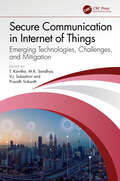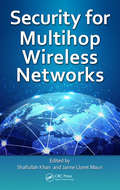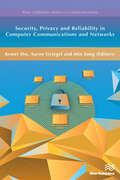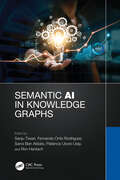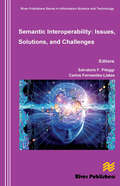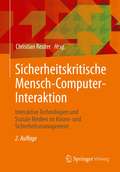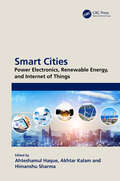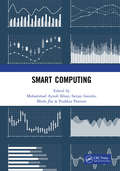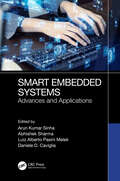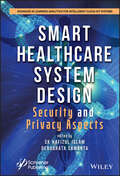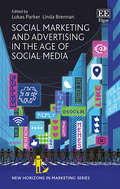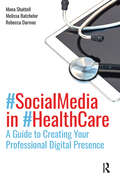- Table View
- List View
The SAGE Handbook of Social Media Marketing
Social media marketing has become indispensable for marketers who utilize social media to achieve marketing objectives ranging from customer care to advertising to commerce. This Handbook explores the foundations and methodologies in analysing the important aspects of social media for organisations and consumers. It investigates critical areas concerning communities, culture, communication and content, and considers social media sales. This Handbook brings together the critical factors in social media marketing as the essential reference set for researchers in this area of continued growth. It is essential reading for postgraduate students, researchers, and practitioners in a range of disciplines exploring the area. Part 1: Foundations of Social Media Marketing Part 2: Methodologies and Theories in Social Media Part 3: Channels and Platforms in Social Media Part 4: Tools, Tactics, and Techniques in Social Media Marketing Part 5: Management and Metrics in Social Media Part 6: Ethical Issues in Social Media
Secure Communication in Internet of Things: Emerging Technologies, Challenges, and Mitigation
The book Secure Communication in Internet of Things: Emerging Technologies, Challenges, and Mitigation will be of value to the readers in understanding the key theories, standards, various protocols, and techniques for the security of Internet of Things hardware, software, and data, and explains how to design a secure Internet of Things system. It presents the regulations, global standards, and standardization activities with an emphasis on ethics, legal, and social considerations about Internet of Things security. Features:● Explores the new Internet of Things security challenges, threats, and future regulations to end-users.● Presents authentication, authorization, and anonymization techniques in the Internet of Things.● Illustrates security management through emerging technologies such as blockchain and artificial intelligence.● Highlights the theoretical and architectural aspects, foundations of security, and privacy of the Internet of Things framework.● Discusses artificial-intelligence-based security techniques, and cloud security for the Internet of Things.It will be a valuable resource for senior undergraduates, graduate students, and academic researchers in fields such as electrical engineering, electronics and communications engineering, computer engineering, and information technology.
Secure Data Management for Online Learning Applications
With the increasing use of e-learning, technology has not only revolutionized the way businesses operate but has also impacted learning processes in the education sector. E-learning is slowly replacing traditional methods of teaching and security in e-learning is an important issue in this educational context. With this book, you will be familiarized with the theoretical frameworks, technical methodologies, information security, and empirical research findings in the field to protect your computers and information from threats. Secure Data Management for Online Learning Applications will keep you interested and involved throughout.
Security and Quality in Cyber-Physical Systems Engineering: With Forewords by Robert M. Lee and Tom Gilb
This book examines the requirements, risks, and solutions to improve the security and quality of complex cyber-physical systems (C-CPS), such as production systems, power plants, and airplanes, in order to ascertain whether it is possible to protect engineering organizations against cyber threats and to ensure engineering project quality.The book consists of three parts that logically build upon each other. Part I "Product Engineering of Complex Cyber-Physical Systems" discusses the structure and behavior of engineering organizations producing complex cyber-physical systems, providing insights into processes and engineering activities, and highlighting the requirements and border conditions for secure and high-quality engineering. Part II "Engineering Quality Improvement" addresses quality improvements with a focus on engineering data generation, exchange, aggregation, and use within an engineering organization, and the need for proper data modeling and engineering-result validation. Lastly, Part III "Engineering Security Improvement" considers security aspects concerning C-CPS engineering, including engineering organizations’ security assessments and engineering data management, security concepts and technologies that may be leveraged to mitigate the manipulation of engineering data, as well as design and run-time aspects of secure complex cyber-physical systems.The book is intended for several target groups: it enables computer scientists to identify research issues related to the development of new methods, architectures, and technologies for improving quality and security in multi-disciplinary engineering, pushing forward the current state of the art. It also allows researchers involved in the engineering of C-CPS to gain a better understanding of the challenges and requirements of multi-disciplinary engineering that will guide them in their future research and development activities. Lastly, it offers practicing engineers and managers with engineering backgrounds insights into the benefits and limitations of applicable methods, architectures, and technologies for selected use cases.
Security for Multihop Wireless Networks
Security for Multihop Wireless Networks provides broad coverage of the security issues facing multihop wireless networks. Presenting the work of a different group of expert contributors in each chapter, it explores security in mobile ad hoc networks, wireless sensor networks, wireless mesh networks, and personal area networks.Detailing technologies
Security Implementation in Internet of Medical Things
Security implementation is crucial in the Internet of Medical Things (IoMT) as it ensures the protection of sensitive medical data and prevents unauthorized access to or manipulation of devices and systems. This book covers different aspects of security implementations and challenges in IoMT and aims to bring researchers together to contribute their findings to recommend new methodologies and feasible solutions for implementing security and novel architectures in artificial intelligence, machine learning, and data science in the field of healthcare and IoT. IoMT includes a wide range of connected medical devices and systems, such as wearable devices, medical sensors, and electronic health records, that collect, store, and share sensitive medical information. Without proper security measures, this information could be compromised, leading to serious privacy breaches, financial fraud, and even physical harm to patients.
Security, Privacy and Reliability in Computer Communications and Networks
Future communication networks aim to build an intelligent and efficient living environment by connecting a variety of heterogeneous networks to fulfill complicated tasks. These communication networks bring significant challenges in building secure and reliable communication networks to address the numerous threat and privacy concerns. New research technologies are essential to preserve privacy, prevent attacks, and achieve the requisite reliability. Security, Privacy and Reliability in Computer Communications and Networks studies and presents recent advances reflecting the state-of-the-art research achievements in novel cryptographic algorithm design, intrusion detection, privacy preserving techniques and reliable routing protocols. Technical topics discussed in the book include: Vulnerabilities and Intrusion DetectionCryptographic Algorithms and EvaluationPrivacyReliable Routing ProtocolsThis book is ideal for personnel in computer communication and networking industries as well as academic staff and collegial, master, Ph.D. students in computer science, computer engineering, cyber security, information insurance and telecommunication systems.
Semantic AI in Knowledge Graphs
Recent combinations of semantic technology and artificial intelligence (AI) present new techniques to build intelligent systems that identify more precise results. Semantic AI in Knowledge Graphs locates itself at the forefront of this novel development, uncovering the role of machine learning to extend the knowledge graphs by graph mapping or corpus-based ontology learning. Securing efficient results via the combination of symbolic AI and statistical AI such as entity extraction based on machine learning, text mining methods, semantic knowledge graphs, and related reasoning power, this book is the first of its kind to explore semantic AI and knowledge graphs. A range of topics are covered, from neuro-symbolic AI, explainable AI and deep learning to knowledge discovery and mining, and knowledge representation and reasoning. A trailblazing exploration of semantic AI in knowledge graphs, this book is a significant contribution to both researchers in the field of AI and data mining as well as beginner academicians.
Semantic Interoperability Issues, Solutions, Challenges
Semantic technologies are experimenting an increasing popularity in the context of different domains and applications. The understanding of any class of system can be significantly changed under the assumption any system is part of a global ecosystem known as Semantic Web.The Semantic Web would be an evolving extension of current Web model (normally referred as Syntactic Web) that introduces a semantic layer in which semantics, or meaning of information, are formally defined.So, semantics should integrate web-centric standard information infrastructures improving several aspects of interaction among heterogeneous systems. This is because common interoperability models are progressively becoming obsolete if compared with the intrinsic complexity and always more distributed focus that feature modern systems. For example, the basic interoperability model, that assumes the interchange of messages among systems without any interpretation, is simple but effective only in the context of close environments. Also more advanced models, such as the functional interoperability model that integrates basic interoperability model with the ability of intepretating data context under the assumption of a shared schema for data fields accessing, appears not able to provide a full sustainable technologic support for open systems.The Semantic Interoperability model would improve common interoperability models introducing the interpretation of means of data. Semantic interoperability is a concretely applicable interaction model under the assumption of adopting rich data models (commonly called Ontology) composed of concepts within a domain and the relationships among those concepts.In practice, semantic technologies are partially inverting the common view at actor intelligence: intelligence is not implemented (only) by actors but it is implicitly resident in the knowledge model. In other words, schemas contain information and the "code" to interpretate it.
Shaping the Future of IoT with Edge Intelligence: How Edge Computing Enables the Next Generation of IoT Applications (River Publishers Series in Communications and Networking)
This book presents the technologies that empower edge intelligence, along with their use in novel IoT solutions. Specifically, it presents how 5G/6G, Edge AI, and Blockchain solutions enable novel IoT-based decentralized intelligence use cases at the edge of the cloud/edge/IoT continuum. Emphasis is placed on presenting how these technologies support a wide array of functional and non-functional requirements spanning latency, performance, cybersecurity, data protection, real-time performance, energy efficiency, and more. The various chapters of the book are contributed by several EU-funded projects, which have recently developed novel IoT platforms that enable the development and deployment of edge intelligence applications based on the cloud/edge paradigm. Each one of the projects employs its own approach and uses a different mix of networking, middleware, and IoT technologies. Therefore, each of the chapters of the book contributes a unique perspective on the capabilities of enabling technologies and their integration in practical real-life applications in different sectors. The book is structured in five distinct parts. Each one of the first four parts focuses on a specific set of enabling technologies for edge intelligence and smart IoT applications in the cloud/edge/IoT continuum. Furthermore, the fifth part provides information about complementary aspects of next-generation IoT technology, including information about business models and IoT skills. Specifically: The first part focuses on 5G/6G networking technologies and their roles in implementing edge intelligence applications. The second part presents IoT applications that employ machine learning and other forms of Artificial Intelligence at the edge of the network. The third part illustrates decentralized IoT applications based on distributed ledger technologies. The fourth part is devoted to the presentation of novel IoT applications and use cases spanning the cloud/edge/IoT continuum. The fifth part discusses complementary aspects of IoT technologies, including business models and digital skills.
Sicherheitskritische Mensch-Computer-Interaktion: Interaktive Technologien und Soziale Medien im Krisen- und Sicherheitsmanagement
Die zweite, aktualisierte Auflage dieses Lehr- und Fachbuchs gibt eine fundierte und praxisbezogene Einführung sowie einen Überblick über Grundlagen, Methoden und Anwendungen der Mensch-Computer-Interaktion im Kontext von Sicherheit, Notfällen, Krisen, Katastrophen, Krieg und Frieden. Dies adressierend werden interaktive, mobile, ubiquitäre und kooperative Technologien sowie soziale Medien vorgestellt. Hierbei finden klassische Themen wie benutzbare (IT-)Sicherheit, Industrie 4.0, Katastrophenschutz, Medizin und Automobil, aber auch Augmented Reality, Crowdsourcing, Shitstorm Management, Social Media Analytics und Cyberwar ihren Platz. Methodisch wird das Spektrum von Usable Safety bis Usable Security Engineering von Analyse über Design bis Evaluation abgedeckt. Das Buch eignet sich ebenso als Lehrbuch für Studierende wie als Handbuch für Fachleute/Personen aus Wissenschaft, Design, Entwicklung und Anwendung.
Simulieren und Entscheiden: Entscheidungsmodellierung, Modellierungsentscheidungen, Entscheidungsunterstützung (Sozialwissenschaftliche Simulationen und die Soziologie der Simulation)
Simulationen geben zunehmend Orientierung für die Entscheidungsfindung in Politik, Ökonomie, Ökologie oder Medizin. Hierzu sind zunächst Modelle zu bilden, wobei die Modellierungsentscheidungen einen großen Effekt auf die Simulationsergebnisse haben. Dieses Zusammenhangs nimmt sich der vorliegende Band an und durchleuchtet Computersimulationen im Kontext von Entscheidungen aus Sicht der Soziologie, Simulationswissenschaft und Philosophie. Dabei stehen drei Fragen im Mittelpunkt: Wie werden Entscheidungen modelliert oder simuliert? Welche metatheoretischen und methodischen Entscheidungen müssen simulierende WissenschaftlerInnen im Zuge der Simulationsstudie treffen? Wie werden organisationale oder politische Entscheidungen durch Modellierungen und Simulationen unterstützt? Die Herausgeber*innenProf. Dr. Nicole J. Saam ist Inhaberin des Lehrstuhls für Methoden der empirischen Sozialforschung am Institut für Soziologie der Friedrich-Alexander Universität Erlangen-Nürnberg. Prof. Michael Resch ist Direktor am HPC Center Stuttgart (HLRS) der Universität Stuttgart. Dr. Andreas Kaminski ist als Leiter der Abteilung “Philosophie der Simulation“ am HPC Center Stuttgart (HLRS) der Universität Stuttgart tätig.
Sixty Shades of Generalized Continua: Dedicated to the 60th Birthday of Prof. Victor A. Eremeyev (Advanced Structured Materials #170)
In this book, well-known scientists discuss modern aspects of generalized continua, in order to better understand modern materials and advanced structures. They possess complicated internal structure, and it requires the development of new approaches to model such structures and new effects caused by it. This book combines fundamental contributions in honor of Victor Eremeyev and his 60th birthday.
Smart Cities: Power Electronics, Renewable Energy, and Internet of Things
This book discusses the integration of power electronics, renewable energy, and the Internet of Things (IoT) from the perspective of smart cities in a single volume. The text will be helpful for senior undergraduate, graduate students and academic researchers in diverse engineering fields including electrical, electronics and communication, and computers. The book: Covers the integration of power electronics, energy harvesting, and the IoT for smart city applications. Discusses concepts of power electronics and the IoT in electric vehicles for smart cities. Examines the integration of power electronics in renewable energy for smart cities. Discusses important concepts of energy harvesting including solar energy harvesting, maximum power point tracking (MPPT) controllers, and switch-mode power supplies (SMPS). Explores IoT connectivity technologies such as long-term evolution (LTE), narrow band NB-IoT, long-range (LoRa), Bluetooth, and ZigBee (IEEE Standard 802.15.4) for low data rate wireless personal communication applications. The text provides the knowledge about applications, technologies, and standards of power electronics, renewable energy, and IoT for smart cities. It will serve as an ideal reference text for senior undergraduate, graduate students and academic researchers in the fields of electrical engineering, electronics and communication engineering, computer engineering, civil engineering, and environmental engineering.
Smart Computing: Proceedings of the 1st International Conference on Smart Machine Intelligence and Real-Time Computing (SmartCom 2020), 26-27 June 2020, Pauri, Garhwal, Uttarakhand, India
The field of SMART technologies is an interdependent discipline. It involves the latest burning issues ranging from machine learning, cloud computing, optimisations, modelling techniques, Internet of Things, data analytics, and Smart Grids among others, that are all new fields. It is an applied and multi-disciplinary subject with a focus on Specific, Measurable, Achievable, Realistic & Timely system operations combined with Machine intelligence & Real-Time computing. It is not possible for any one person to comprehensively cover all aspects relevant to SMART Computing in a limited-extent work. Therefore, these conference proceedings address various issues through the deliberations by distinguished Professors and researchers. The SMARTCOM 2020 proceedings contain tracks dedicated to different areas of smart technologies such as Smart System and Future Internet, Machine Intelligence and Data Science, Real-Time and VLSI Systems, Communication and Automation Systems. The proceedings can be used as an advanced reference for research and for courses in smart technologies taught at graduate level.
Smart Connected World: Technologies and Applications Shaping the Future
This book provides an overview of the emerging smart connected world, and discusses the roles and the usage of underlying semantic computing and Internet-of-Things (IoT) technologies. The book comprises ten chapters overall, grouped in two parts. Part I “Smart Connected World: Overview and Technologies” consists of seven chapters and provides a holistic overview of the smart connected world and its supporting tools and technologies. Part II “Applications and Case Studies” consists of three chapters that describe applications and case studies in manufacturing, smart cities, health, and more. Each chapter is self-contained and can be read independently; taken together, readers get a bigger picture of the technological and application landscape of the smart connected world. This book is of interest for researchers, lecturers, and practitioners in Semantic Web, IoT and related fields. It can serve as a reference for instructors and students taking courses in hybrid computing getting abreast of cutting edge and future directions of a connected ecosystem. It will also benefit industry professionals like software engineers or data scientists, by providing a synergy between Web technologies and applications. This book covers the most important topics on the emerging field of the smart connected world. The contributions from leading active researchers and practitioners in the field are thought provoking and can help in learning and further research. The book is a valuable resource that will benefit academics and industry. It will lead to further research and advancement of the field. Bharat K. Bhargava, Professor of Computer Science, Purdue University, United States
Smart Contracts: Technological, Business and Legal Perspectives
This book brings together a series of contributions by leading scholars and practitioners to examine the main features of smart contracts, as well as the response of key stakeholders in technology, business, government and the law. It explores how this new technology interfaces with the goals and content of contract law, introducing and evaluating several mechanisms to improve the 'observability' and reduce the costs of verifying contractual obligations and performance. It also outlines various 'design patterns' that ensure that end users are protected from themselves, prevent cognitive accidents, and translate expectations and values into more user-oriented agreements. Furthermore, the chapters map the new risks associated with smart contracts, particularly for consumers, and consider how they might be alleviated. The book also discusses the challenge of integrating data protection and privacy concerns into the design of these agreements and the broad range of legal knowledge and skills required. The case for using smart contracts goes beyond 'contracts' narrowly defined, and they are increasingly used to disrupt traditional models of business organisation. The book discusses so-called decentralised autonomous organisations and decentralised finance as illustrations of this trend.This book is designed for those interested in looking to deepen their understanding of this game-changing new legal technology.
Smart Distributed Embedded Systems for Healthcare Applications (Explainable AI (XAI) for Engineering Applications)
This book discusses the applications and optimization of emerging smart technologies in the field of healthcare. It further explains different modeling scenarios of the latest technologies in the healthcare system and compares the results to better understand the nature and progress of diseases in the human body, which would ultimately lead to early diagnosis and better treatment and cure of diseases with the help of distributed technology. Covers the implementation models using technologies such as artificial intelligence, machine learning, and deep learning with distributed systems for better diagnosis and treatment of diseases. Gives in-depth review of technological advancements like advanced sensing technologies such as plasmonic sensors, usage of RFIDs, and electronic diagnostic tools in the field of healthcare engineering. Discusses possibilities of augmented reality and virtual reality interventions for providing unique solutions in medical science, clinical research, psychology, and neurological disorders. Highlights the future challenges and risks involved in the application of smart technologies such as cloud computing, fog computing, IOT, and distributed computing in healthcare. Confers to utilize the AI and ML and associated aids in healthcare sectors in the post-Covid 19 period to revitalize the medical setup. Contributions included in the book will motivate technological developers and researchers to develop new algorithms and protocols in the healthcare field. It will serve as a vast platform for gaining knowledge regarding healthcare delivery, health- care management, healthcare in governance, and health monitoring approaches using distributed environments. It will serve as an ideal reference text for graduate students and researchers in diverse engineering fields including electrical, electronics and communication, computer, and biomedical fields.
Smart Embedded Systems: Advances and Applications
"Smart Embedded Systems: Advances and Applications" is a comprehensive guide that demystifies the complex world of embedded technology. The book journeys through a wide range of topics from healthcare to energy management, autonomous robotics, and wireless communication, showcasing the transformative potential of intelligent embedded systems in these fields. This concise volume introduces readers to innovative techniques and their practical applications, offers a comparative analysis of wireless protocols, and provides efficient resource allocation strategies in IoT-based ecosystems. With real-world examples and in-depth case studies, it serves as an invaluable resource for students and professionals seeking to harness the power of embedded technology to shape our digital future. Salient Features: 1. The book provides a comprehensive coverage of various aspects of smart embedded systems, exploring their design, implementation, optimization, and a range of applications. This is further enhanced by in-depth discussions on hardware and software optimizations aimed at improving overall system performance. 2. A detailed examination of machine learning techniques specifically tailored for data analysis and prediction within embedded systems. This complements the exploration of cutting-edge research on the use of AI to enhance wireless communications. 3. Real-world applications of these technologies are extensively discussed, with a focus on areas such as seizure detection, noise reduction, health monitoring, diabetic care, autonomous vehicles, and communication systems. This includes a deep-dive into different wireless protocols utilized for data transfer in IoT systems. 4. This book highlights key IoT technologies and their myriad applications, extending from environmental data collection to health monitoring. This is underscored by case studies on the integration of AI and IoT in healthcare, spanning topics from anomaly detection to informed clinical decision-making. Also featured is a detailed evaluation and comparison of different system implementations and methodologies. This book is an essential read for anyone interested in the field of embedded systems. Whether you're a student looking to broaden your knowledge base, researchers looking in-depth insights, or professionals planning to use this cutting-edge technology in real-world applications, this book offers a thorough grounding in the subject.
Smart Healthcare System Design: Security and Privacy Aspects (Advances in Learning Analytics for Intelligent Cloud-IoT Systems)
The purpose of this book is to help achieve a better integration between the work of researchers and practitioners in a single medium for capturing state-of-the-art IoT solutions in healthcare applications to address how to improve the proficiency of wireless sensor networks (WSNs) in healthcare. It explores possible automated solutions in everyday life, including the structures of healthcare systems built to handle large amounts of data, thereby improving clinical decisions; which is why this book will prove invaluable to professionals who want to increase their understanding of recent challenges in the IoT-enabled healthcare domain. The 14 chapters address various aspects of the IoT system, such as design challenges, theory, various protocols, and implementation issues, and also include several case studies. Smart Healthcare System: Security and Privacy Aspects covers the introduction, development, and applications of smart healthcare models that represent the current state-of-the-art of various domains. The primary focus will be on theory, algorithms, and their implementation targeted at real-world problems. It will deal with different applications to give the practitioner a flavor of how IoT architectures are designed and introduced into various situations. More particularly, this volume consists of 14 chapters contributed by authors well-versed in the subject who are devoted to reporting the latest findings on smart healthcare system design.
Smittestopp − A Case Study on Digital Contact Tracing (Simula SpringerBriefs on Computing #11)
This open access book describes Smittestopp, the first Norwegian system for digital contact tracing of Covid-19 infections, which was developed in March and early April 2020. The system was deployed after five weeks of development and was active for a little more than two months, when a drop in infection levels in Norway and privacy concerns led to shutting it down. The intention of this book is twofold. First, it reports on the design choices made in the development phase. Second, as one of the only systems in the world that collected population data into a central database and which was used for an entire population, we can share experience on how the design choices impacted the system's operation. By sharing lessons learned and the challenges faced during the development and deployment of the technology, we hope that this book can be a valuable guide for experts from different domains, such as big data collection and analysis, application development, and deployment in a national population, as well as digital tracing.
Social Engineering in Cybersecurity: Threats and Defenses
In today’s digitally interconnected world, the threat landscape has evolved to include not just sophisticated technical exploits but also the art of human manipulation. Social engineering attacks have emerged as a formidable and often underestimated threat to information security. The primary aim of this textbook is to provide a comprehensive and in-depth exploration of social engineering attacks. The book seeks to equip cybersecurity professionals, IT practitioners, students, and anyone concerned with information security with the knowledge and tools needed to recognize, prevent, and mitigate the risks posed by social engineering. The scope of this textbook is broad and multifaceted. It covers a wide range of social engineering attack vectors, including phishing, vishing, pretexting, baiting, tailgating, impersonation, and more. Each attack vector is dissected, with detailed explanations of how they work, real-world examples, and countermeasures. Key Features • Comprehensive Coverage: Thorough exploration of various social engineering attack vectors, including phishing, vishing, pretexting, baiting, quid pro quo, tailgating, impersonation, and more. • Psychological Insights: In-depth examination of the psychological principles and cognitive biases that underlie social engineering tactics. • Real-World Case Studies: Analysis of real-world examples and high-profile social engineering incidents to illustrate concepts and techniques.• Prevention and Mitigation: Practical guidance on how to recognize, prevent, and mitigate social engineering attacks, including security best practices. • Ethical Considerations: Discussion of ethical dilemmas and legal aspects related to social engineering that emphasizes responsible use of knowledge. This comprehensive textbook on social engineering attacks provides a deep and practical exploration of this increasingly prevalent threat in cybersecurity. It covers a wide array of attack vectors, including phishing, vishing, pretexting, and more, offering readers an in-depth understanding of how these attacks work. The book delves into the psychology behind social engineering and examines the cognitive biases and emotional triggers that make individuals susceptible. Real-world case studies illustrate concepts and techniques while practical guidance equips readers with the knowledge to recognize, prevent, and mitigate social engineering threats.
Social Marketing and Advertising in the Age of Social Media (New Horizons in Marketing series)
Reviewing and analysing the most relevant concepts, theories and strategies related to the field, this timely book reveals what makes for strong social marketing and social advertising campaigns. With a comprehensive understanding of social advertising models and their applications, chapters present original case studies and scenarios from international researchers to illustrate strategies and concepts in practice. Exploring the mechanics of social media, contributors highlight what makes a successful campaign. They evaluate the use and impact of emotions in social power, exploring the power of storytelling, whilst weighing ethical implications. The book covers important and upcoming areas of interest in the field including the rise of social media influencers, the use of memes, the functionality of social media, and the use of fear, guilt and shame in communications campaigns as well as positive emotions. This book will assist marketing academics and practitioners in the development of successful campaigns as it highlights not only what these campaigns look like, but also why they achieve success. It will also prove an excellent guide for government organisations and public policy makers interested in using social marketing for health promotion and social change.
Social Media, Freedom of Speech, and the Future of our Democracy
A broad explanation of the various dimensions of the problem of "bad" speech on the internet within the American context. One of the most fiercely debated issues of this era is what to do about "bad" speech-hate speech, disinformation and propaganda campaigns, and incitement of violence-on the internet, and in particular speech on social media platforms such as Facebook and Twitter. In Social Media, Freedom of Speech, and the Future of our Democracy, Lee C. Bollinger and Geoffrey R. Stone have gathered an eminent cast of contributors--including Hillary Clinton, Amy Klobuchar, Sheldon Whitehouse, Newt Minow, Cass Sunstein, Jack Balkin, Emily Bazelon, and others--to explore the various dimensions of this problem in the American context. They stress how difficult it is to develop remedies given that some of these forms of "bad" speech are ordinarily protected by the First Amendment. Bollinger and Stone argue that it is important to remember that the last time we encountered major new communications technology-television and radio-we established a federal agency to provide oversight and to issue regulations to protect and promote "the public interest." Featuring a variety of perspectives from some of America's leading experts on this hotly contested issue, this volume offers new insights for the future of free speech in the social media era.
Social Media in Health Care: A Guide to Creating Your Professional Digital Presence
A practical, essential guide to social media for health care professionals, Social Media in Health Care equips readers with the skills to build their online brand, share their professional knowledge with a wider audience, and become a trusted source of information and thought leader in their field.Authors Mona Shattell, Melissa Batchelor, and Rebecca Darmoc explain the principles behind building a respected digital presence and developing meaningful online connections, while providing practical tips for navigating the five major social media platforms: Twitter, LinkedIn, Facebook, Instagram, and YouTube. Everyone from health care students to the most seasoned professionals will benefit from the 3C’s Framework outlined in the book: Consume, Contribute, and Create.Social Media in Health Care can be read cover to cover or used as quick reference guide. Topics include: Exercises for novice, intermediate, and advanced users Best practices for consuming, sharing, and creating content Tips for readers to build their social media presence and professional brand Recommendations for using digital platforms to expand professional networks Patient privacy concerns and how to avoid ethical pitfalls Social media can start conversations and serve as an open line of communication between peers, the public, and patients. Social Media in Health Care guides members of the medical community in how to use social media to help educate the public and specific patient communities about health care and health policy, make connections with industry leaders and peers, and enhance their professional reputation.

